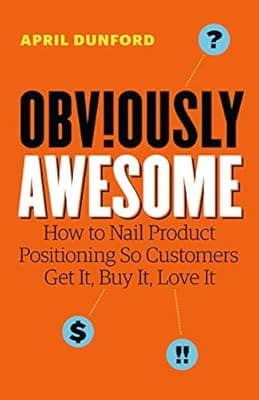
Obviously Awesome: How to Nail Product Positioning so Customers Get It, Buy It, Love It
by April Dunford
13 highlights
1 notes
Highlights
Positioning is the act of deliberately defining how you are the best at something that a defined market cares a lot about.
Page 4
Even a world-class product, poorly positioned, can fail.
Page 21
After repositioning our product as a data warehouse, we immediately saw the difference in our first meetings with prospects. Instead of instantly telling us “no, thanks,” they now stopped to listen. They stopped comparing us with the database they had already purchased. They intuitively understood the specific problem we could solve and the value to their business. Most importantly, prospects stopped telling us to get lost, and they started buying our solution.
Page 34
These are the Five (Plus One) Components of Effective Positioning: Competitive alternatives. What customers would do if your solution didn’t exist. Unique attributes. The features and capabilities that you have and the alternatives lack. Value (and proof). The benefit that those features enable for customers. Target market characteristics. The characteristics of a group of buyers that lead them to really care a lot about the value you deliver. Market category. The market you describe yourself as being part of, to help customers understand your value. (Bonus) Relevant trends. Trends that your target customers understand and/or are interested in that can help make your product more relevant right now.
Page 45
It’s important to really understand what customers compare your solution with, because that’s the yardstick they use to define “better.” For example, your solution might be much easier to use than the product that other startups are selling, but if the real alternative in the mind of a customer is Excel, you can’t say your product is easier to use unless it is easier to use than a spreadsheet.
Page 47
Your unique attributes are your secret sauce, the things you can do that the alternatives can’t.
Page 48
If unique attributes are your secret sauce, then value is the reason why someone might care about your secret sauce.
Page 49
Your target market is the customers who buy quickly, rarely ask for discounts and tell their friends about your offerings.
Page 50
Suppose your company was running out of cash and if the team didn’t close a certain amount of business by the end of the month, very bad things were going to happen. What types of customers would you focus on and why?
Page 50
Your market category can work for you or against you. If you choose your category wisely, all the assumptions are working for you. You don’t have to tell customers who your competitors are. It’s assumed! You don’t have to list every feature, because it’s assumed that all products in the category have basic category functions. However, a poor category choice can turn that power against a product. If the market category we select triggers assumptions that do not apply to our product, then a good portion of our marketing and sales efforts are going to be spent battling those assumptions.
Page 51
Trends can help customers understand why a product is important right now.
Page 55
Time for a test. In the early days of a company, when you are still learning about what customers love and hate about your offering, you need to get your product in front of a fairly wide set of potential customers. Test your offering on this diverse audience so you can see patterns emerge. Do bigger businesses love your product more than smaller ones?
Page 68
Think of your product as a fishing net. You have a theory that your net is good for catching grouper, but you haven’t fished with it yet so you aren’t certain what you might catch. At first, you’ll want to go where there are lots of different fish and see what you pull up.
Page 69
My Notes
For auropitch this is inbound
Page 25